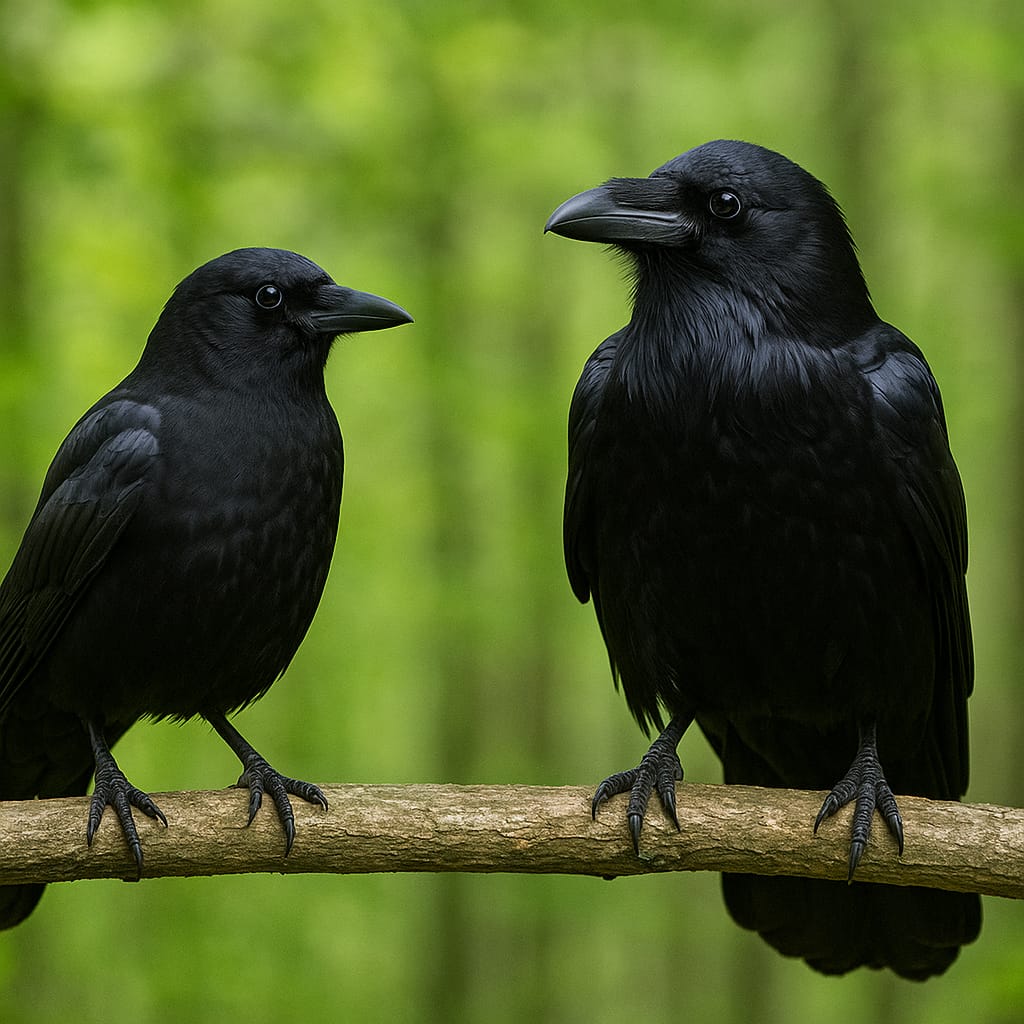Crow Vs Raven – What’s the Difference?
Crow or Raven – What’s the Difference?
How do you distinguish a raven, rook, crow, hooded crow, and jackdaw?
Let’s break it down clearly and simply. We’ll share helpful tips so you can recognize each bird easily and confidently.
A Personal Moment: Why I Wanted to Learn This
Last winter, I was walking through a foggy park near my grandmother’s home. I saw a massive black bird sitting on a fence, staring like it knew something I didn’t. “Is that a crow… or a raven?” I asked myself.
Later, I realized I had no idea how to tell them apart—and that small moment of curiosity inspired me to dig deep into the differences. This guide is what I wish I had that day.
Same Family, Different Birds
When we think of ravens, we often picture a black bird. But in the corvid family, not all birds are entirely black.
One of the 120+ corvid species is the magpie, which has striking white and blue plumage.
The five most confusing ones to identify are:
- Raven
- Rook
- Crow (Carrion Crow)
- Hooded Crow
- Jackdaw
All of them are common in Europe and belong to the genus “ravens and crows.”
Main Differences at a Glance
- Here’s what we’ll cover to tell these birds apart:
- Beak
- Plumage
- Size
- Call (Reputation)
- Special Features
1. Beak – The Easiest Clue
Corvids have very distinct beak shapes. Here’s a quick breakdown:
Jackdaw
Beak: Short and pointed

Rook
Beak: Long, pointed, slightly curved
Special tip: Base of the beak is light grey
📸 Rook – Photo: Gallinago_media/Shutterstock

Carrion Crow
Beak: Thick, curved at the front
Base: Uniformly black

Hooded Crow
Beak: Thick, curved at the front

Raven
Beak: Large and strongly curved downward

Myth Buster:
It’s often claimed that corvids have yellow beaks—not true.
That’s likely confusion with blackbirds (a thrush), or other birds like:
Alpine chough (yellow beak)
Alpine crow (red beak)
2. Size – Who’s the Biggest?
Yes, these birds differ significantly in size:
- Bird Size
- Raven Up to 67 cm
- Hooded Crow Up to 52 cm
- Carrion Crow Up to 47 cm
- Rook Up to 46 cm
- Jackdaw Only up to 39 cm
Tip: It’s tricky to estimate size from a distance—regular observation really helps.
3. Call – What Do They Sound Like?
The reputation (call) of these birds can be a helpful way to identify them.
Jackdaw
Sounds like: kjak, schack, kjöck, kjarr, kji
Rook & Crow
- Hoarse voice
- R often barely audible
- Common sounds: kraa, korr, krrr
Raven & Hooded Crow
- Louder: kraa, arrr
- Deeper tone compared to smaller corvids
5. Systematics – Where They Belong
| Bird | Size | Beak | Plumage | Reputation | Special Feature |
|---|---|---|---|---|---|
| Jackdaw | Up to 39 cm | Short | Dark brown, black | kjak, schack, kjöck, kjarr, kji | Round head |
| Rook | Up to 46 cm | Long, pointed, curved | Black, slightly reddish | kraa, korr, krrr (hoarse) | Light grey beak base |
| Carrion Crow | Up to 47 cm | Thick, curved | Black, slightly bluish | kraa, korr, krrr (often 3x) | Dark beak base |
| Hooded Crow | Up to 52 cm | Thick, curved | Black and grey | kraa, arrr | Grey feathers look like a coat |
| Raven | Up to 67 cm | Large, curved downward | Black with green/violet | kraa, arrr | Long feathers at the throat |
To better understand their classification:
Class: Birds
Order: Passerines
Suborder: Songbirds
Family: Corvids
Genus: Ravens and Crows
Examples: Crow, Raven, Rook, Hooded Crow, Jackdaw
Conclusion
So next time you see a black bird and wonder, “Crow or raven?”—you’ll have all the clues you need.
Remember:
- Look at the beak
- Estimate the size
- Listen to the call
- Notice special traits like plumage or beak color
- With a little practice, you’ll be spotting jackdaws, rooks, and ravens like a pro
Crow or Raven: Test Your Bird ID Skills!
Can you tell a rook from a raven? A jackdaw from a hooded crow? Test your knowledge with this 5-question quiz based on key differences!
Q1: Which bird has the largest beak, strongly curved downward?
Q2: Which bird can be recognized by a light grey base on its beak?
Q3: Which bird is the smallest among the five?
Q4: Which bird has a two-tone appearance, black and grey plumage?
Q5: Which bird has long feathers at its throat and a deep “kraa” voice?
Similar Posts
Wild Rabbit: A Complete Guide to Their Life in Nature
Wild rabbit Features & Special Characteristics of Wild Rabbits The first time I saw a wild rabbit, I was hiking through a field at sunset. It had short ears, soft gray-brown fur, and…
Rural exodus of foxes
Introduction Foxes, once considered shy forest dwellers, have become a familiar sight in many German cities. Drawn by abundant food and safety from hunters, these clever animals have adapted remarkably to urban life—so much so…
Most Popular Animals of the forest
Introduction: Forests are more than just trees they’re full of life. From the ground to the treetops, animals find food, shelter, and a safe place to live. Tiny insects crawl in the soil, birds nest…
How Often Do Lions Hunt Each Week? (The Wild Truth Explained)
Introduction Welcome readers! You clicked on this page because you wanted to know about How Often Do Lions Hunt Each Week? In this comprehensive guide, I will try to explain in as simple a way…
Camels: Masterpieces of Nature
Introduction You stupid camel!” “You bactrian camel!” – Camels have a very bad reputation. Yet these desert animals are extremely intelligent and possess fascinating abilities.In this article we will explore general information about camel. …
Beautiful animals in the world
Introduction: Are you looking for what are the most beautiful animals in the world? you have come to the right place. We show you great photos of the most beautiful animals on earth! With all…







